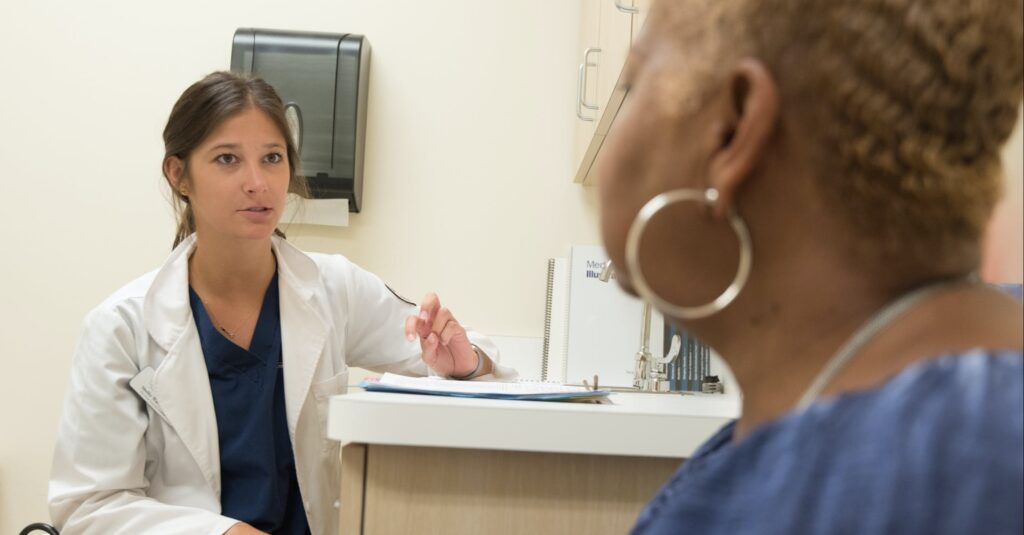
Transfers and Admissions: Guide & FAQs
Researching Colleges New College Scorecard Offers [...]

The American Academy of Physician Associates (AAPA), which represents 159,000 physician assistants across the US, is currently engaged in a $22 million campaign to convince state legislatures, medical regulatory agencies, and employers to legally change the title ‘physician assistant’ to ‘physician associate’ in all statutes and rules. The AAPA asserts that the title “assistant” is misleading and doesn’t fully represent the role and its level of autonomy.
As Leslie Clayton, who has been a physician assistant for 23 years, told Kaiser Health News, “There is an assumption that there has to be some sort of direct, hands-on oversight for us to do our work, and that’s not been accurate for decades…We don’t assist. We provide care as part of a team.”
The American Medical Association, which represents over 250,000 physicians, is against the title change. The organization argues it will misrepresent physician assistants’ role as “junior doctors” and constitute an unwise step toward PAs’ establishing independent private practices.
This dispute illustrates the public’s confusion over physician assistants’ role in the provision of medical care, as well as the overlap in what PAs and physicians do. Like doctors, physician assistants provide preventative care. They also diagnose illnesses and prescribe medication. This article addresses the question physician assistant vs. doctor: what is the difference? It also covers:
According to the U.S. Bureau of Labor Statistics (BLS), a physician assistant’s responsibilities include recording patients’ medical histories, performing examinations, ordering and interpreting tests, and diagnosing, treating, and counseling patients. To become a physician assistant, one must complete a two-year master’s degree in physician assistant studies at an accredited program that includes clinical rotations in a variety of specializations. Physician assistants work in hospitals, clinics, and private practices. Though they must practice under the supervision of a physician, PAs frequently operate with significant autonomy.
As cardiology physician assistant Michael G. Clark explains, “In general, what I do is no different from my cardiologist physician colleagues.” Clark’s practice is general and preventive cardiology; he treats patients during follow-up appointments, supervises and interprets stress tests, and handles relevant administrative duties. As well, he helps supervise PA students during their cardiology clinical rotations.
The primary difference between PAs and doctors is that PAs cannot practice independently. PAs work under the supervision of doctors, who assume medical responsibility. This doesn’t mean PAs always take direct orders. Physician assistants typically perform their duties with a high level of autonomy. Their responsibilities include diagnosing and treating patients, prescribing medicine, and performing minor surgery.
Physicians must meet more extensive education requirements than PAs. Physicians and surgeons earn either a Medical Doctor (MD) or Doctor of Osteopathic Medicine (DO) degree. Both require four years of medical school to complete (not including residencies). The degrees differ in that osteopathic doctors focus more on preventive and holistic medicine.
Accounting for undergraduate study, medical school, residency, and board certification, physicians train for nearly 15 years on average. The average physician also assumes $200,000 of medical school debt, according to the Association of American Medical Colleges (AAMC).
PAs spend about six years in undergraduate and graduate school, though they also typically acquire at least three years of healthcare work experience before entering a PA graduate program. While PA programs cover many of the same medical topics as do MD and DO programs, their curricula are less in-depth. The average PA accrues over $111,000 in school loan debt, per the National Commission on Certification of Physician Assistants figures.
One of the key differences in the ‘PA vs MD’ comparison is that PAs have a much easier time switching specializations than physicians, who lock into their medical specialties during their residencies. Each clinical rotation a PA completes during their program qualifies them to work in that sector post-graduation.
The first step to becoming a physician assistant is to earn a Master of Science in Physician Assistant Studies (followed by certification and licensure post-graduation—more on that below). PA master’s degree programsusually take 26 months. During their course of study, PA students complete both didactic coursework and clinical rotations.
Physician assistant programs impose strict admissions requirements, including prerequisite undergraduate coursework and at least 500 hours of direct patient care. As a result, most PA program applicants hold a bachelor’s degree in biology and have healthcare experience working as a registered nurse (RN), emergency medical technician (EMT), paramedic, medical assistant, or physical therapy or occupational therapy assistant.
PA program application requirements also typically include undergraduate transcripts with a GPA of 3.0 or higher, GRE scores (the MCAT is not required), a resume, letters of recommendation, and a personal essay. Applicants typically submit their applications through the Centralized Application Service for Physician Assistants (CASPA).
In their first year, PA students take didactic coursework to prepare for rotations in their second year of study. At the University of Pittsburgh’s Master of Science in Physician Assistant Studies program, course titles include:
Students then gain clinical experience by completing five-week clinical rotations in areas of medicine including pediatrics, family medicine, emergency medicine, internal medicine, surgery, behavioral health, obstetrical and gynecological medicine, and an elective rotation (where they can either revisit a previous rotation or explore a new one).
Completing a rotation in PA school qualifies graduates to work in that specialization, meaning PAs can change their scope of practice during their career path without additional training. Licensed PAs who wish to specialize in an area they didn’t study in their PA program can earn a certification. The National Commission on Certification of Physician Assistants (NCCPA) offers Certificates of Added Qualifications (CAQs) in other areas of specialization, including cardiovascular and thoracic surgery, hospital medicine, nephrology, orthopedic surgery, and psychiatry.
Physician assistant studies graduates must pass the Physician Assistant National Certifying Exam (PANCE) to become Physician Assistant-Certified (PA-C). After that, they complete state licensure requirements, which include a background check and education verification. Practicing PAs are required to complete 100 continuing education hours every two years, and every ten years must pass a recertification exam.
Questions or feedback? Email editor@noodle.com

Researching Colleges New College Scorecard Offers [...]

Resume How to Explain a Gap [...]

What's the Difference Between Graduate School and College? Despite a [...]

How Do Online Classes Work? Online learning at the college level [...]
![When searching for scholarships, it’s key to evaluate the different categories available: Understanding which categories you fit into will streamline your search and application process for scholarships matching your qualifications and needs. Using Scholarship Platforms Scholarship search engines and resources like Fastweb and Scholarships.com provide access to extensive scholarship databases. By entering personal and academic […]](https://resources.noodle.com/wp-content/uploads/2024/03/pexels-maitree-rimthong-1602726.jpg)
When searching for scholarships, it's key to evaluate the different [...]
Categorized as: Physicians Assistant Studies, Nursing & Healthcare